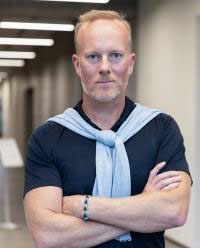Faculty Spotlight: Ted Sargent

By Ruth Barrera
Ted Sargent received a B.Sc.Eng. (Engineering Physics) from Queen's University in 1995 and a Ph.D. in Electrical and Computer Engineering (Photonics) from the University of Toronto in 1998. He was appointed Assistant Professor in the Electrical and Computer Engineering department at the University of Toronto in 1998. Sargent was then appointed Associate Professor in 2002 and afterwards earned the appointment of Full Professor in 2005. He served as Associate Chair in Research for the Faculty of Applied Science from 2009-2012 and then served as Vice-Dean in Research for the Faculty of Applied Science and Engineering from 2012-2016. He left Toronto as Vice President-International of Research and Innovation in 2020.
Professor Sargent's jouney has brought him here where he joins Northwestern’s Department of Chemistry and Department of Electrical and Computer Engineering, and is affiliated with the International Institute for Nanotechnology.
Why are you excited to join the faculty at Northwestern?
The tradition of highly collaborative research across disciplines – for which Northwestern is so justly famous – was among the biggest attractors.
What is one thing that you found unexpected or surprised you or your family upon arriving in Chicago?
I have been astonished with what a wonderful, beautiful, and collegial community there is to be found on the North Shore. From tennis courts to bike trails to places to run and places to go to the beach, it’s a terrific environment. The beauty of the locale is exceeded only by the warmth and community-minded spirit of its inhabitants
What are you most looking forward to by being at Northwestern?
I am excited to contribute to mission-oriented team research that builds on Northwestern’s renowned excellence in Chemistry and the physical sciences generally, and its outstanding platform across Engineering research of all stripes, certainly ECE, and also very much extending to materials science and engineering, as well as chemical and mechanical engineering, Each foundational areas are crucial to the projects I am excited about.
What do you hope to accomplish and/or contribute to the department and university?
The thing I love most about my job is working with doctoral students to help them define their professional development plans, and then to help them as they seek to deliver on their vision. This is centered first around their development of an outstanding portfolio of first-authored publications; but, especially once this is well on track, it radiates outward, such as to the development of their own professional networks and skills. I’d love to learn about, and ultimately contribute to, the culture of graduate student development, in the context of research and beyond, at NU.
Which of your current research interests do you plan to carry out first at Northwestern and what are their potential applications?
I plan three areas, though I am open to contributing my expertise and capabilities in areas proposed by colleagues. In the first, I wish to advance the field of solar energy harvesting, lowering its cost and increasing its efficiency: this I do by working with a new class materials, the metal halide perovskites. Second, I work on decarbonizing the chemicals and fuels sectors: we use renewable (a.k.a. low-carbon) electricity to power the electrochemical reduction of CO2 to valuable (and, today, carbon-intensive) fuels like ethanol and propanol, and chemicals like ethylene and propylene. In the third, we work on new materials for consumer electronics, such as those that can assist in new infrared sensors for smartphones and for self-driving cars.
What Chemistry class / professor did you enjoy the most as an undergraduate or graduate student and why?
I loved instruction on energy chemistry. This is a broad area looking at the fundamental potential to interconvert energy among its forms (electrical, chemical, mechanical, etc.), and it’s highly relevant to the urgent problems of solar energy harvesting, and to the critical topic of energy storage. It teaches us the limits of efficiency and it enables pursuit of strategies that come closest to these limits, while keeping devices as simple as possible – but not simpler! It also mandates reach to adjacent fields of the natural sciences (definitely physics, CS, and mathematics), and very much across engineering and applied science domains.
Describe your teaching style.
I like to bring examples from the latest research into the classroom. Even in undergraduate classes, I find it rewarding and stimulating to bring the latest breakthrough published in JACS to the discussion, to dive in collaboratively with the group into its significance, and make linkages to fundamentals.
What is one thing not on your CV that you would like us to know?
In tennis I am between a 3.0 and a 3.5, and am looking for people to hit with (at any level!).
How do you feel about using your formal training in electrical engineering in the Chemistry Department?
It’s a thrill to have appointments in both Chemistry and in ECE. I remember back in the early 2000s, once I had earned tenure, scanning the horizon widely for where I wanted to go next. I saw what was happening in the field of materials chemistry for energy and optoelectronics, such as with colloidal quantum dots, nanoparticles, and organic semiconductors – with much of the work at the vanguard at NU. And I wanted to add these capabilities to my repertoire because I felt I could do so much more if I embraced the very latest advances in materials chemistry, physical chemistry, inorganic chemistry, solid-state chemistry, and energy chemistry, into the projects I initiated. It was a risky yet ultimately rewarding move, one made more feasible by my own background in engineering physics / applied physics, which provided solid foundations in the natural sciences and mathematics as well as in application. In sum, the joint appointments in Chemistry and ECE accord perfectly with my own journely in research and graduate training, and thus provide an ideal environment both for me and for my doctoral students, present and future.
